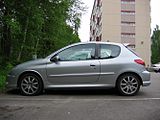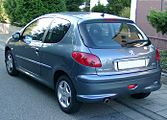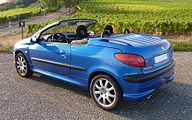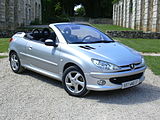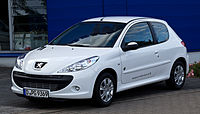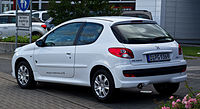Peugeot 206
| Peugeot | |
|---|---|
|
Peugeot 206 three-door (1998-2003)
|
|
| 206 | |
| Production period: | since 1998 |
| Class : | Small car |
| Body versions : | Station wagon , sedan , cabriolet , station wagon |
| Engines: |
Otto engines : 1.1–2.0 liters (44–130 kW) Diesel engines : 1.4–2.0 liters (50–80 kW) |
| Length: | 3822-4188 mm |
| Width: | 1652-1673 mm |
| Height: | 1365-1460 mm |
| Wheelbase : | 2442 mm |
| Empty weight : | 985-1285 kg |
| Previous model | Peugeot 205 |
| successor | Peugeot 207 |
| Other measured values | |
| CO 2 emissions: | 113-204 g / km |
| Combined fuel consumption (EC standard): | 4.3-8.6 l / 100 km |
| Stars in the Euro NCAP - Crash Test |
|
The Peugeot 206 is a small car produced by the French vehicle manufacturer Peugeot . The vehicle came onto the market in the summer of 1998 as the successor to the Peugeot 205 . The body was designed by Murat Günak . The vehicle was produced in the French plant in Poissy and in Mulhouse until 2013. The SW station wagon version was also built in Ryton-on-Dunsmore , England, until December 2006 . As of December 2012, 8,358,217 Peugeot 206s were produced. The 207 Compact (206+) model was produced in Argentina until the end of 2016. It is still being built by Iran Khodro . Around 10 million Peugeot 206s had been produced by the end of 2018.
Model history
In August 1998 Peugeot introduced the 206 on the market. It replaced the 205 sold for 15 years, which could no longer keep up with modern competition due to incomplete security equipment. The basic variants of the 206 are the three- and five-door hatchback sedans. In the late summer of 2000, the 206 CC appeared , a coupé-convertible with a two-part electrohydraulic folding roof , which Peugeot positioned as a fun car.
An introduced in July 2002 Combi variant SW (unofficially S tation W agon) is based on the five-door sedan with an unchanged wheelbase, but because of the 19.3 cm bigger rear overhang enlarged trunk. A special feature of the car is the tailgate window that can be opened separately.
Facelift
In March 2003, the entire series received a subtle facelift with clear glass headlights, modified taillights, a larger logo on the rear instead of on the trunk handle and bumpers painted in body color (here depending on the model). The conspicuous air inlets on the front are purely engine-dependent and not part of the facelift.
There was also a new 1.4-l-16V and a 2.0-l-16V engine, the latter only for the sport versions RC , WRC, S16 ( called GTi up to 1999 model ) and GT .
A new feature was introduced in vehicle electronics from 2000 onwards: CAN / CAN was switched to multiplex, which enables better vehicle error diagnostics.
S16 model
This vehicle variant was available with 2 different engines, once from 1998 to 1999 with the type RFR (as in the GT) with 99 kW (135 PS) and from 1999 to 2003 with the type RFN with better exhaust emissions and 101 kW (138 PS). At the front, the S16 has a different grille, a larger air inlet in the bumper, clear glass headlights and larger fog lights than the smaller power levels, with the exception of the diesel version with the 2-liter double-acting engine.
On the older models of the S16 series there was a widening strip above the front wheel arches, this was also used on the GTI model, whereby the tire size was severely limited to 195 / 55R15 with the 6.5 J 15 H2 rim used, later this was omitted.
GT model
The GT is based on the S16 and was delivered with the RFR engine with 99 kW (135 PS). It has a larger front and rear apron from ZENDER, which was only available through the Peugeot accessories catalog. The tires were 205/45 R16 with "Ouragan" wheels 6J / 16 H2.
RC model
The RC (also GTI 180 in Great Britain and Australia), built from 2003 to 2005, offered as a top model with the price of 21,500 € in 2003 standard equipment such as automatic air conditioning, adjustable Recaro bucket seats with RC logo, folding mirrors, rain sensor, in Body color painted bumpers as well as protective strips and door handles, aluminum pad on pedals, gear knob and fuel filler cap, 17 "Atlantis aluminum wheels with 205 / 40R17 tires, chrome-plated twin exhaust pipes, chrome trim strip on the front apron, interior fittings partly made of leather and Alcantara and a roof spoiler that extends up to A downforce of 250 N. A technically complex (and therefore expensive) manifold and a metal catalytic converter were used for the engine built by the Mecachrome company .
A Helmholtz resonator , which ends in an aluminum distributor, was used on the inlet side for better air supply. The DOHC engine EW10J4S (RFK) got a variable intake camshaft control (VVT) and a 5-way supported, finely balanced camshaft to reach the maximum speed of 7300 / min. A lighter flywheel allows the engine to rev up faster. According to the factory specifications, the engine achieves 130 kW (177 hp) at 7000 rpm and a maximum torque of 202 Nm at 4750 rpm.
The acceleration from 0-100 km / h is 7.4 seconds according to the factory specification. The first gear is longer than on the S16 models (66 km / h at 7000 rpm).
The chassis was adapted to the driving performance with harder springs in the front and different shock absorber settings. The reinforcement struts of the 206 SW were built into the twist beam rear axle for better cornering stability.
The brake system is reinforced compared to other variants. At the front there are 26 mm thick, internally ventilated discs with a 283 mm diameter, and discs 247 mm × 8 mm in the rear.
The WRC model was also equipped with sponsor stickers, tinted rear and vent windows, WRC floor mats and special paintwork. The 2003 version (Edition 1) was Chronos Silver, the 2004 version (Edition 2) was Nevada Red.
In mid-2006, the assembly of parts kits started in Malaysia as Naza Bestari . The notchback variant 206 Sedan , which is manufactured by Iran Khodro , has been available in some markets in the Middle East since the end of 2006 .
With more than five million vehicles sold by 2005, the Peugeot 206 became the most successful small car in Europe. In Germany it was the best-selling import car for four years (from 2001 to 2004) and has been the best-selling Peugeot there since July 2007.
206 CC
The Peugeot 206 CC was manufactured from September 2000 to February 2007 and was available with one of two gasoline engines or a diesel engine. The vehicle inherited the Peugeot 205 Cabriolet , which was discontinued in 1996. The successor was the Peugeot 207 CC presented in March 2007 .
The 206 CC is the first affordable convertible with an electro-hydraulic folding roof . It was already shown at numerous auto shows in 1999 and received a very positive response from customers, which also contributed to the fact that it was the best-selling convertible in Europe at the time.
The near-series model was presented similar to the study. Some playful details were left out, such as the point-shaped lamps for the brake lights on the rear trunk lid. These were integrated into the "gills" on them, giving the car something like a yacht. Other details of the study were omitted, such as the heart symbols on the slightly pink-looking seats, which initially gave the study a bit of the character of a “Barbie & Ken car”.
With this vehicle, Peugeot continued its tradition in the field of convertible roof tops. Peugeot already had a similar vehicle in its range in the 1930s (the Peugeot 402 Eclipse). His idea was taken up again in 1996 with the introduction of the Mercedes-Benz SLK. The Turkish designer Murat Günak, who worked on this vehicle, was in charge of the external shape of the Peugeot 206 (and 206 CC and 307) after switching from Mercedes to Peugeot. The roof construction of the CC was developed together with the French body construction specialist Heuliez and is closely related to the construction of the open Opel Tigra, also by Heuliez. The 206 CC presents the designers with the same challenges as all vehicles with a two-part retractable roof. When open, these roof structures occupy a lot of space in the rear of the vehicle, which is therefore always very high and wide, which is more or less cleverly concealed, in the case of the 206 CC through the boat-like design with rails on the left and right and ribs on the boot lid. In order to keep the overall length of the trunk within limits, the roof element above the seats must not be too long. That is why the 206 CC, like most other retractable roof convertibles, has a windshield that is pulled extremely far back, which comes very close to the heads of those sitting in front and creates an uncomfortable "board in front of the head" for people over 1.90 meters. Feeling “leads.
The vehicle was sold out shortly after its introduction and resulted in very long delivery times. A similar folding roof convertible from the Peugeot 307 was later added . Peugeot's convertibles became the most popular open-top vehicles on the German market. The 206 CC is a stable value vehicle on the used car market, especially in the later submitted 80 kW diesel variant with soot particle filter.
206+
With the appearance of the Peugeot 207 CC and SW in spring and summer 2007, the production of the corresponding model variants of the Peugeot 206 was discontinued and has been replaced by the inexpensive 206+ since March 2009. The front section and the fittings are similar to the 207, while the rear with newly designed bumpers and rear lights is different from the 207. The 206+ was available as a three- or five-door variant with petrol engines with 1.1 liter displacement and 44 kW (60 PS), 1.4 liters and 55 kW (75 PS) or a 50 kW diesel engine (1.4 HDI éco 70, from model year 2011 1.4 HDi 70 FAP with diesel soot particle filter ).
In some South American markets, the 206+ has been built as the 207 Compact since December . The addition “Compact” serves to distinguish it from the 207, which is also available, but - as an expensive import vehicle - is only offered as a CC and RC. For this reason, the 207 Compact is available in Argentina, for example, with five doors with a hatchback, as a sedan and station wagon (SW).
In Western Europe , the car had 5-speed manual transmission , power steering , anti-lock braking system , internally ventilated disc brakes at the front and drum brakes at the rear, front and side airbags , steering column and driver's seat with height adjustment, central locking with radio remote control, electric windows , tachometer , fog lights , a 40/60 split Rear seat back and radio preparation for two loudspeakers in the front with roof antenna, which Peugeot left out after a while. Head airbags were not offered for the 206+; the electronic stability program ESP with traction control ASR was not available for the 44 kW engine and was otherwise only available in a package together with the manual air conditioning , as was electrically adjustable exterior mirrors only with an on-board computer . With model year 2011, ESP became part of the standard equipment.
The 206+ was available as a special generation model from February 2012 to December 2012 , after which it was withdrawn from the range.
Rallying
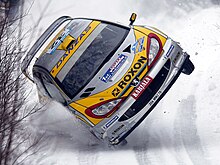
In 1999 Peugeot introduced the 206 in rallying . The version of the works team was equipped with all-wheel drive and brought Peugeot the greatest success in rallying since the 1980s and the predecessor model Peugeot 205 . The appearance of a light compact car with all-wheel drive and a powerful engine in the midst of the WRC World Championship dominated by large sedans such as the Subaru Impreza or the Mitsubishi Lancer represented a small revolution. Marcus Grönholm won the drivers' championship of the WRC World Championship in the 2000 and 2002 seasons. In addition, Peugeot won the WRC constructors championship three times in a row with the 206 from 2000 to 2002. The successor to the rally, based on the 307 , introduced in 2004, was unable to repeat the success of its predecessor and, in particular, only rarely prevailed against the PSA internal competitor Citroën Xsara .
The 206 RC version, equipped with 130 kW (177 hp), aluminum wheels and sports seats, was to benefit from the sporty image . For licensing reasons it is called 206 RC in Germany . In other European countries it is sold as the 206 GTi 180 .
Engine variants
Petrol engines
| model | Engine (type) | Displacement | power | construction time | variants |
|---|---|---|---|---|---|
| 1.1 | TU1JP (HFX) | 1124 cc | 44 kW (60 hp) | 1998-2012 | Hatchback, SW |
| 1.4 | TU3JP (KFX) | 1360 cc | 55 kW (75 PS) | 1998-2001 | Hatchback |
| TU3JP (KFW) | 2001–2012 | Hatchback, SW | |||
| 1.4 16V | ET3J4 (KFU) | 1360 cc | 65 kW (88 PS) | 2003-2006 | Hatchback, SW |
| 1.6 | TU5JP (NFZ) | 1587 cc | 65 kW (89 PS) | 1998-2001 | Hatchback |
| 1.6 16V | TU5JP4 (NFU) | 1587 cc | 80 kW (109 PS) | 2001-2007 | Hatchback, SW, CC |
| 2.0 16V S16 / GT | EW10JA (RFR) | 1997 cc | 99 kW (135 hp) | 1999-2001 | Hatchback |
| 2.0 16V S16 (GTs) | EW10J4 (RFN) | 1997 cc | 100 kW (136 hp) | 2001-2007 | Hatchback, SW, CC |
| 2.0 16V RC | EW10J4S (RFK) | 1997 cc | 130 kW (177 hp) | 2003-2006 | Hatchback |
| 2.0 16V RC WRC Edition | EW10J4S (RFK) | 1997 cc | 130 kW (177 hp) | 2003-2004 | Hatchback |
| The GTi 180 designation is common in some markets such as Australia and Great Britain. The special models WRC Edition and GTi CC were only produced in limited numbers. |
|||||
Diesel engines
| model | Engine (type) | Displacement | power | construction time | variants |
|---|---|---|---|---|---|
| 1.4 HD i 1) éco | DV4TD (8HX / HZ) | 1398 cc | 50 kW (68 hp) | 2001–2012 | Hatchback, SW |
| 1.6 HD i 2) 16V ( FAP ) | DV6TED4 (9HZ / HY) | 1560 cc | 80 kW (109 PS) | 2004-2007 | Hatchback, SW, CC |
| 1.9 D | DW8 (WJY / WJZ) | 1868 cc | 51 kW (70 hp) | 1998-2001 | Hatchback |
| 2.0 HDi | DW10TD (RHY) | 1997 cc | 66 kW (90 PS) | 2000-2006 | Hatchback, SW |
Technical specifications
| 1.1 l | 1.4 l | 1.4 l 16V | 1.6 l 16V | 2.0 l 16V | 2.0 l 16V | 1.4 l HDi éco | 2.0 l HDi | 1.6 l HDi (FAP) | |
|---|---|---|---|---|---|---|---|---|---|
| Engine type and
Number of cylinders |
R4 petrol engine with multi-point injection |
R4 diesel engine with common rail injection |
|||||||
| Displacement | 1124 cc | 1360 cc | 1360 cc | 1587 cc | 1997 cc | 1997 cc | 1398 cc | 1997 cc | 1560 cc |
| Max. Power at 1 / min |
44 kW (60 hp) 5500 |
55 kW (75 PS) 5500 |
65 kW (88 PS) 5250 |
80 kW (109 PS) 5800 |
100 kW (136 hp) 6100 |
130 kW (177 hp) 7000 |
50 kW (68 hp) 4000 |
66 kW (90 PS) 4000 |
80 kW (109 PS) 4000 |
| Max. Torque at 1 / min |
94 Nm 2700 |
120 Nm 2800 |
133 Nm 3250 |
147 Nm 4000 |
190 Nm 4100 |
202 Nm 4750 |
160 Nm 2000 |
205 Nm 1900 |
245 Nm 1750 |
| Gearbox, as standard | 5-speed manual transmission | ||||||||
| Gearbox, optional | - | 4-stage automatic (not SW) |
- | 4-stage automatic (also SW) |
- | - | - | - | |
| Top speed | 158 km / h 160 km / h 2 |
170 km / h 160 km / h 1 171 km / h 2 |
178 km / h 179 km / h 2 |
196 km / h 188 km / h 1 194 km / h 2 |
210 km / h | 220 km / h | 168 km / h 168 km / h 2 |
179 km / h 179 km / h 2 |
190 km / h 190 km / h 2 |
| Acceleration in s from 0–100 km / h |
15.4 15.8 2 |
12.5 17.3 1 13.3 2 |
12.2 12.7 2 |
10.5 12.9 1 10.5 2 |
8.9 | 7.4 | 14.7 14.1 2 |
12.6 12.3 2 |
10.0 10.4 2 |
| Fuel consumption (according to EEC guidelines, combined l / 100 km) |
6.3 S 6.5 S 2 |
6.3 S 6.9 S 1 6.4 S 2 |
6.5 S 6.5 S 2 |
6.7 S 7.5 S 1 6.7 S 2 |
7.8 S | 8.6 S | 4.3 D 4.3 D 2 |
5.3 D 5.3 D 2 |
4.8 D 4.8 D 2 |
| Combined CO 2 emissions in g / km |
151 156 2 |
151 165 1 153 2 |
155 155 2 |
161 179 1 159 2 |
187 | 204 | 113 113 2 |
144 144 2 |
126 126 2 |
| Emission standard according to EU classification | Euro 3 + D4 | Euro 4 | Euro 3 + D4 | Euro 3 | Euro 4 | ||||
1 with sequential 4-speed automatic transmission
2 model SW with 5-speed manual transmission
| 60 | 73/75 | HDi éco 68/70 | HDi FAP 68/70 | |
|---|---|---|---|---|
| Engine type and
Number of cylinders |
R4 petrol engine with multi-point injection |
R4 diesel engine with common rail injection |
||
| Displacement | 1124 cc | 1360 cc | 1398 cc | |
| Max. Power at 1 / min |
44 kW (60 hp) 5500 |
55 kW (75 PS) 5500 |
50 kW (68 hp) 4000 |
|
| Max. Torque at 1 / min |
94 Nm 3300 |
120 Nm 3400 |
160 Nm 2000 |
|
| transmission | 5-speed manual transmission | |||
| Top speed | 159 km / h | 173 km / h | 169 km / h | |
| Acceleration in s from 0–100 km / h |
16.1 | 13.1 | 13.8 | |
| Fuel consumption (according to EEC guidelines, combined l / 100 km) |
5.7 S | 6.3 S. | 4.2 D | 4.0 D |
| Combined CO 2 emissions in g / km |
135 | 150 | 110 | 104 |
| Emission standard according to EU classification | Euro 4 | 5 euro | ||
Trivia
The Citroën C2, which has been sold in China since autumn 2006, is not the European C2 model , but a 206 that has been relabeled and given a facelift.
The 206 has been sold in Europe under the name 206+ since spring 2009. This model is already being sold in South America as the Peugeot 207 Compact . It is intended to fill the large gap between 107 and 207 that was created by the discontinuation of 106 .
The 206, 206 SD and 207i (the name of the 206+ in Iran) are still produced at Iran Khodro and are among the best-selling cars in 2016.
See also
References
- Sales brochure Peugeot 206/206 SW (November 2004)
- Prices and equipment (January 1, 2005)
literature
- Dieter Korp : Peugeot 206 (from October 1998). Now I'm helping myself , Volume 215, Motorbuch Verlag, Stuttgart 2000, ISBN 3-613-02082-3 .
Individual evidence
- ↑ Results of the Peugeot 206 (2000) in the Euro NCAP crash test. Retrieved March 31, 2009 .
- ↑ La Peugeot 206 fête ses 20 ans: retour sur une icône de la Marque. Retrieved January 16, 2019 (French).
- ↑ Peugeot 206: Delicate retouches. motorline.cc, April 16, 2003
- ↑ Excerpt from the translation of Peugeot spec sheet http://www.peugeot206rc.fr.st. In: Peugeot. Retrieved January 29, 2017 .
- ↑ Peugeot old price lists Peugeot 206 RC. April 15, 2003. Retrieved January 29, 2017 .
- ↑ WRC Edition. Peugeot, April 15, 2003, accessed January 30, 2017 .
- ^ WRC Edition 2nd Peugeot, March 1, 2004, accessed January 30, 2017 .
- ↑ Peugeot 206+ 5 door
- ↑ Peugeot 206+ 3 door
- ↑ heise.de
- ↑ Peugeot 206 as Citroen C2 in China, photos autoblog.com
- ↑ Peugeot 206 - Overview. In: www.ikco.ir. Retrieved January 14, 2017 .
- ↑ Peugeot 206 SD - Overview. In: www.ikco.ir. Retrieved January 14, 2017 .
- ↑ 207i - Overview. In: www.ikco.ir. Retrieved January 14, 2017 .
- ^ Pride, Peugeot 405 Extend Lead in Sales. December 25, 2016, accessed January 14, 2017 .
Web links
- Official website
- Iran Khodro Company official website Peugeot 206
- Peugeot 206+: The refurbished endurance runner
- Peugeot 206 as Chinese Citroen C2
| Timeline of the Peugeot models since 1945 | ||||||||||||||||||||||||||||||||||||||||||||||||||||||||||||||||||||||||||||
|---|---|---|---|---|---|---|---|---|---|---|---|---|---|---|---|---|---|---|---|---|---|---|---|---|---|---|---|---|---|---|---|---|---|---|---|---|---|---|---|---|---|---|---|---|---|---|---|---|---|---|---|---|---|---|---|---|---|---|---|---|---|---|---|---|---|---|---|---|---|---|---|---|---|---|---|---|
| Type | 40s | 50s | 60s | 70s | 80s | 90s | 2000s | 2010s | 2020s | |||||||||||||||||||||||||||||||||||||||||||||||||||||||||||||||||||
| 5 | 6th | 7th | 8th | 9 | 0 | 1 | 2 | 3 | 4th | 5 | 6th | 7th | 8th | 9 | 0 | 1 | 2 | 3 | 4th | 5 | 6th | 7th | 8th | 9 | 0 | 1 | 2 | 3 | 4th | 5 | 6th | 7th | 8th | 9 | 0 | 1 | 2 | 3 | 4th | 5 | 6th | 7th | 8th | 9 | 0 | 1 | 2 | 3 | 4th | 5 | 6th | 7th | 8th | 9 | 0 | 1 | 2 | 3 | 4th | 5 | 6th | 7th | 8th | 9 | 0 | 1 | 2 | 3 | 4th | 5 | 6th | 7th | 8th | 9 | 0 | |
| Microcar | ion | |||||||||||||||||||||||||||||||||||||||||||||||||||||||||||||||||||||||||||
| 106 | 107 | 108 | ||||||||||||||||||||||||||||||||||||||||||||||||||||||||||||||||||||||||||
| Small car | 104 | 205 | 206 | |||||||||||||||||||||||||||||||||||||||||||||||||||||||||||||||||||||||||
| 202 | 207 | 208 I. | 208 II | |||||||||||||||||||||||||||||||||||||||||||||||||||||||||||||||||||||||||
| Compact class | 204 | 301 | ||||||||||||||||||||||||||||||||||||||||||||||||||||||||||||||||||||||||||
| 203 | 304 | 305 | 306 | 307 | 308 I. | 308 II | ||||||||||||||||||||||||||||||||||||||||||||||||||||||||||||||||||||||
| Lower middle class | 309 | 408 I. | 408 II | |||||||||||||||||||||||||||||||||||||||||||||||||||||||||||||||||||||||||
| Middle class | 403 | 404 | 405 | 406 | 407 | |||||||||||||||||||||||||||||||||||||||||||||||||||||||||||||||||||||||
| 505 | 508 I. | 508 II | ||||||||||||||||||||||||||||||||||||||||||||||||||||||||||||||||||||||||||
| upper middle class | 504 | |||||||||||||||||||||||||||||||||||||||||||||||||||||||||||||||||||||||||||
| 604 | 605 | 607 | ||||||||||||||||||||||||||||||||||||||||||||||||||||||||||||||||||||||||||
| Coupe | RCZ | |||||||||||||||||||||||||||||||||||||||||||||||||||||||||||||||||||||||||||
| 404 coupe | 504 coupe | 406 coupe | 407 coupe | |||||||||||||||||||||||||||||||||||||||||||||||||||||||||||||||||||||||||
| Minivan | 1007 | |||||||||||||||||||||||||||||||||||||||||||||||||||||||||||||||||||||||||||
| Crossover | 2008 I. | 2008 II | ||||||||||||||||||||||||||||||||||||||||||||||||||||||||||||||||||||||||||
| 3008 I. | ||||||||||||||||||||||||||||||||||||||||||||||||||||||||||||||||||||||||||||
| SUV | 3008 II | |||||||||||||||||||||||||||||||||||||||||||||||||||||||||||||||||||||||||||
| 4008 | ||||||||||||||||||||||||||||||||||||||||||||||||||||||||||||||||||||||||||||
| 4007 | ||||||||||||||||||||||||||||||||||||||||||||||||||||||||||||||||||||||||||||
| 5008 II | ||||||||||||||||||||||||||||||||||||||||||||||||||||||||||||||||||||||||||||
| Compact van | 5008 I. | |||||||||||||||||||||||||||||||||||||||||||||||||||||||||||||||||||||||||||
| Van | 806 | 807 | ||||||||||||||||||||||||||||||||||||||||||||||||||||||||||||||||||||||||||
| Off-road vehicle | P4 | |||||||||||||||||||||||||||||||||||||||||||||||||||||||||||||||||||||||||||
| Pick up | 403 truck | 404 pick up | 504 pick up | Pick up | Land trek | |||||||||||||||||||||||||||||||||||||||||||||||||||||||||||||||||||||||
| High roof combination | Traveler | |||||||||||||||||||||||||||||||||||||||||||||||||||||||||||||||||||||||||||
| Box van | 205 Multi / Fourgonnette | |||||||||||||||||||||||||||||||||||||||||||||||||||||||||||||||||||||||||||
| Bipper | ||||||||||||||||||||||||||||||||||||||||||||||||||||||||||||||||||||||||||||
| partner | partner | Rifter | ||||||||||||||||||||||||||||||||||||||||||||||||||||||||||||||||||||||||||
| Transporter | D3 | D4 | J7 | J9 | Expert | Expert | Expert | |||||||||||||||||||||||||||||||||||||||||||||||||||||||||||||||||||||
| J5 | boxer | boxer | ||||||||||||||||||||||||||||||||||||||||||||||||||||||||||||||||||||||||||
|
|
||||||||||||||||||||||||||||||||||||||||||||||||||||||||||||||||||||||||||||
| Timeline of the Peugeot models from 1889 to 1944 | ||||||||||||||||||||||||||||||||||||||||||||||||||||||||
|---|---|---|---|---|---|---|---|---|---|---|---|---|---|---|---|---|---|---|---|---|---|---|---|---|---|---|---|---|---|---|---|---|---|---|---|---|---|---|---|---|---|---|---|---|---|---|---|---|---|---|---|---|---|---|---|---|
| Type | 1880s | 1890s | 1900s | 1910s | 1920s | 1930s | 1940s | |||||||||||||||||||||||||||||||||||||||||||||||||
| 9 | 0 | 1 | 2 | 3 | 4th | 5 | 6th | 7th | 8th | 9 | 0 | 1 | 2 | 3 | 4th | 5 | 6th | 7th | 8th | 9 | 0 | 1 | 2 | 3 | 4th | 5 | 6th | 7th | 8th | 9 | 0 | 1 | 2 | 3 | 4th | 5 | 6th | 7th | 8th | 9 | 0 | 1 | 2 | 3 | 4th | 5 | 6th | 7th | 8th | 9 | 0 | 1 | 2 | 3 | 4th | |
| Small car | 1 | 2 | 3 / 4 | 5 / 6 / 7 / 8 | 21 / 24 / 30 / 31 | 37 | 54 | 57 | 69 "Bébé" | B P1 / B3 / P1 "Bébé" [1] | 161/172 "Quadrilette" | 190 | ||||||||||||||||||||||||||||||||||||||||||||
| 26 / 27 / 28 | 48 | 126 | 201 | 202 ... | ||||||||||||||||||||||||||||||||||||||||||||||||||||
| Compact class | 14 / 15 / 25 | 56 | 58 | 68 | VA / VC / VY [1] | V2C / V2Y [1] | VD / VD2 [1] | 159 | 163/163 BS | 301 | 302 | |||||||||||||||||||||||||||||||||||||||||||||
| 33 / 36 | 63 | 99 | 108 | 118 | 125 | 173 / 177 / 181 / 183 | ||||||||||||||||||||||||||||||||||||||||||||||||||
| Middle class | 9 / 10 / 11 / 12 | 16 / 17 / 19 / 32 | 49/50 | 65/67 | 77 | 78 | 88 | 127 | 143 | 153 | 153 B / BR | 176 | 401 | 402 | ||||||||||||||||||||||||||||||||||||||||||
| 18th | 39 | 61 | 71 | 81 | 96 | 106 | 116 | 126 | 138 | 175 | ||||||||||||||||||||||||||||||||||||||||||||||
| upper middle class | 23 | 42/43/44 | 62 | 72 | 82 | 92 | 104 | 112/117/122/130/134 | 139 | 145/146/148 | 174 / 184 | 601 | ||||||||||||||||||||||||||||||||||||||||||||
| 66 | 76 | 83 | 93 | 135 | 156 | |||||||||||||||||||||||||||||||||||||||||||||||||||
| Upper class | 80 | 103 | 113 | 141 | 147/150 | |||||||||||||||||||||||||||||||||||||||||||||||||||
| 85 | 95 | 105 | ||||||||||||||||||||||||||||||||||||||||||||||||||||||
| Convertible / Spider | 91 | 101/120 | 133 / 111/129/131 | 136 | 144 | |||||||||||||||||||||||||||||||||||||||||||||||||||
| Box van | 13 | 22nd | 34/35 | |||||||||||||||||||||||||||||||||||||||||||||||||||||
| minibus | 20 / 29 | 107 | ||||||||||||||||||||||||||||||||||||||||||||||||||||||



